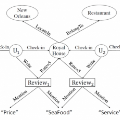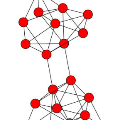Temporal heterogeneous information network (temporal HIN) embedding, aiming to represent various types of nodes of different timestamps into low dimensional spaces while preserving structural and semantic information, is of vital importance in diverse real-life tasks. Researchers have made great efforts on temporal HIN embedding in Euclidean spaces and got some considerable achievements. However, there is always a fundamental conflict that many real-world networks show hierarchical property and power-law distribution, and are not isometric of Euclidean spaces. Recently, representation learning in hyperbolic spaces has been proved to be valid for data with hierarchical and power-law structure. Inspired by this character, we propose a hyperbolic heterogeneous temporal network embedding (H2TNE) model for temporal HINs. Specifically, we leverage a temporally and heterogeneously double-constrained random walk strategy to capture the structural and semantic information, and then calculate the embedding by exploiting hyperbolic distance in proximity measurement. Experimental results show that our method has superior performance on temporal link prediction and node classification compared with SOTA models.
翻译:时态异构信息网络嵌入旨在将不同时间戳的各种类型节点表示为低维空间,同时保留结构和语义信息,是各种实际任务中非常重要的。研究人员在欧几里得空间中进行了大量的时态异构信息网络嵌入研究,并取得了一些可观的成果。然而,许多实际网络都具有分层特性和幂律分布,并且不是欧几里得空间的等距变换。最近,超空间中的表示学习被证明对具有分层和幂律结构的数据有效。受到这种特性的启发,我们提出了一个超空间异构时态网络嵌入(H2TNE)模型,用于处理时态异构信息网络。具体而言,我们利用一种时间和异构双重限制的随机游走策略来捕捉结构和语义信息,然后利用超空间距离进行距离度量计算嵌入结果。实验结果表明,相比于SOTA模型,我们的方法在时态链接预测和节点分类上具有卓越的性能。


